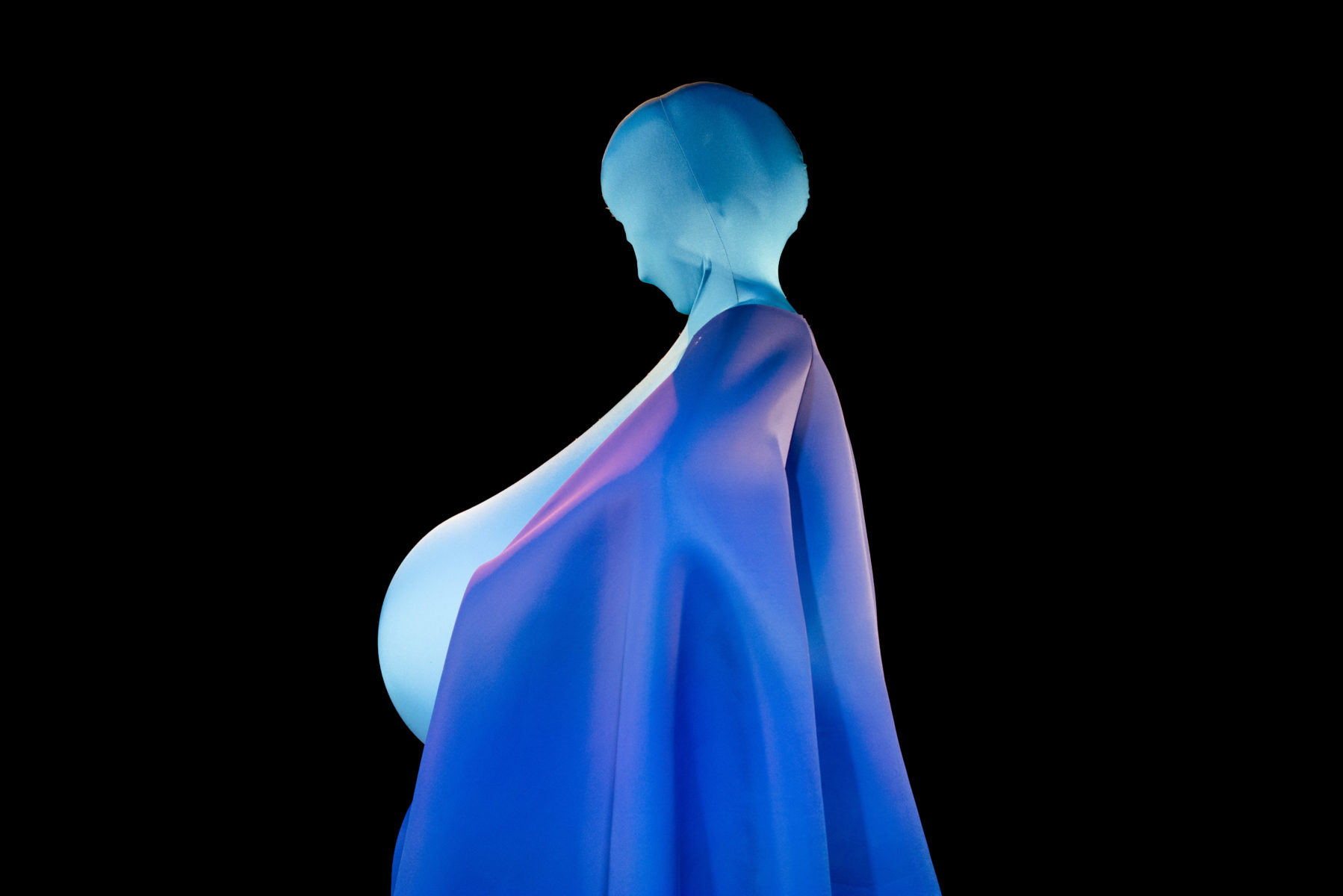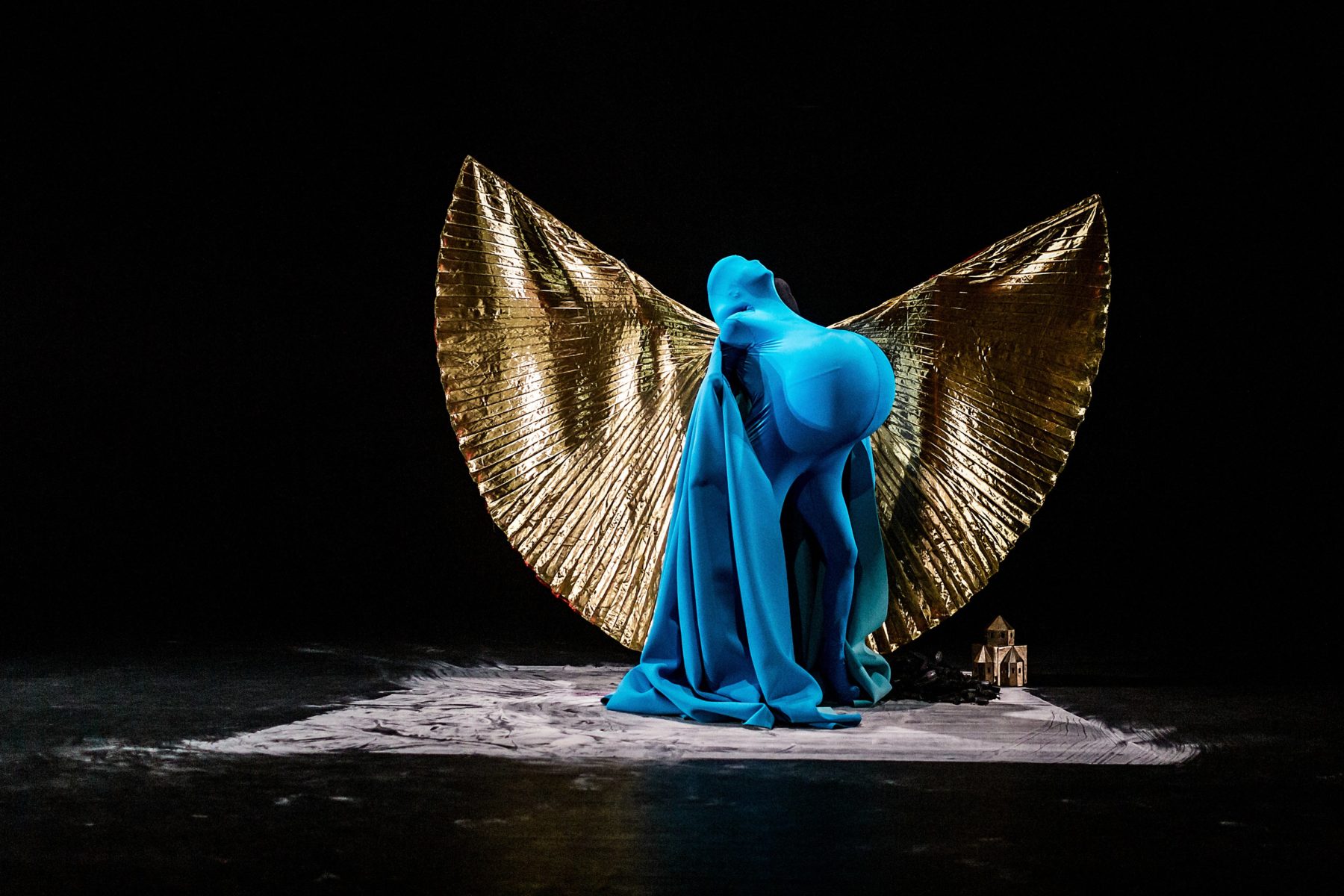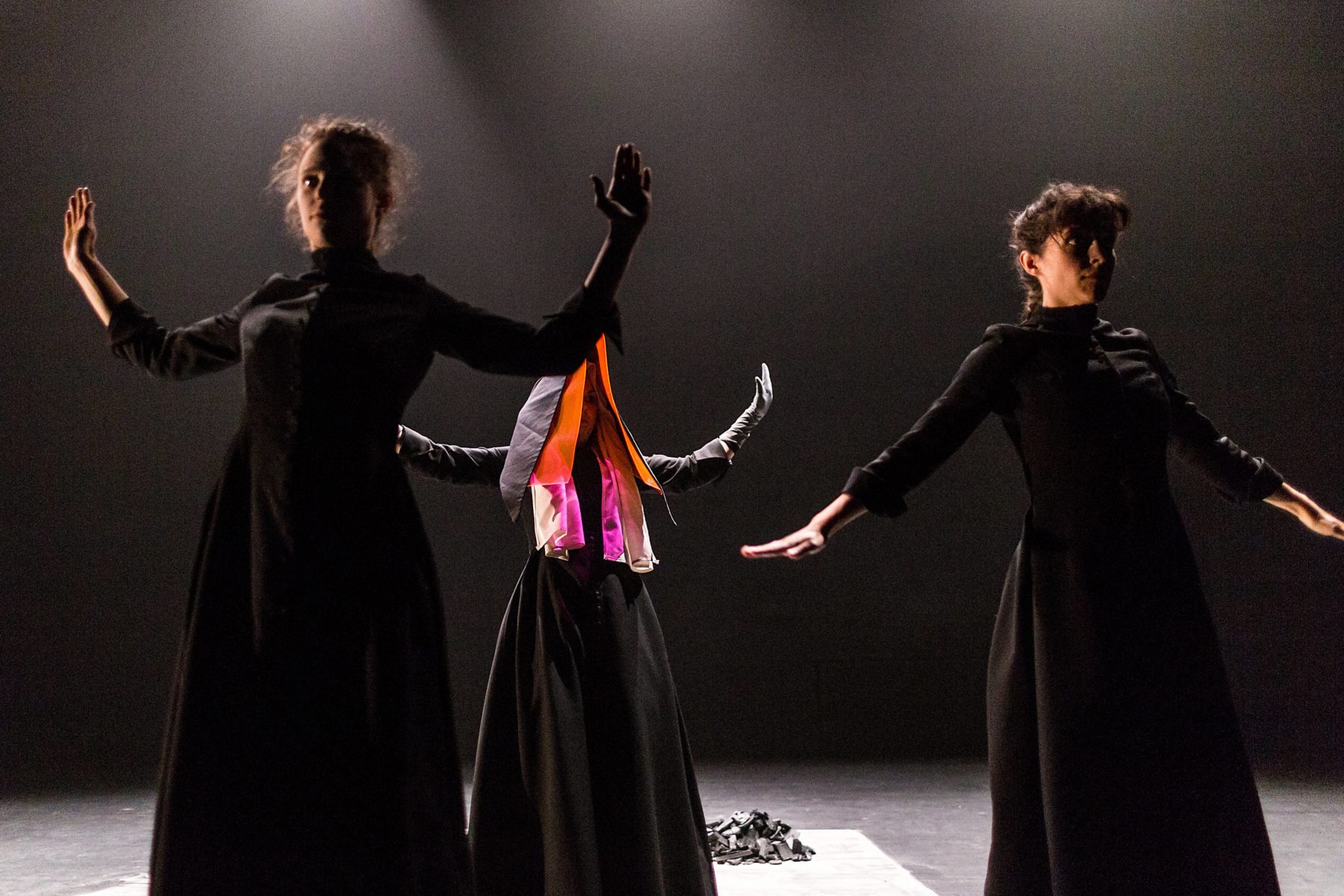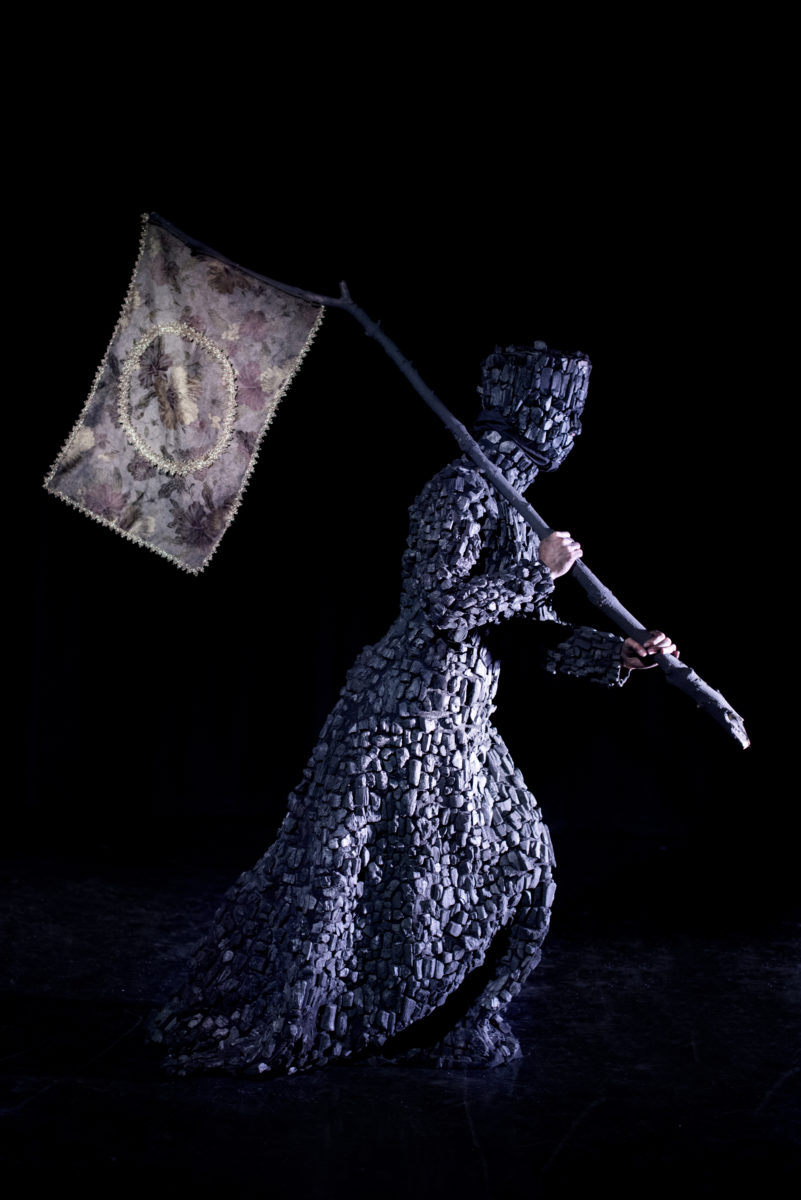Posted By Kate Lane
TRINITY IN VILNIUS
Brave New Worlds is a collaboration between Italian theatre maker Valentina Ceschi, Lithuanian artist Guoda Jaruseviciute and myself, a British scenographer. As a collective we create design-led performance, where the narrative, movement and moments on stage are instigated by an aesthetic concept or visual theme. Our work sits on the border between live art, theatre and dance, creating emotive, visually provocative productions. We do not distinguish and separate our roles. Instead, we all work as directors, scenographers and performers. In our devising process we start by exploring concept through visual research. We then create rough three-dimensional forms, which are tried out in the rehearsal room to discover both movement and composition possibilities. The work at this stage can be seen as a series of tableau vivants. Our final role in the devising process is acting as visual dramaturgs, piecing the work together through images. Our work evolves through close collaboration with sound and lighting artists, or photographers.
We have had a number of residences, principally in the United Kingdom and Berlin, and were keen to work in Vilnius in Lithuania to where Guoda had recently returned, after living in Berlin for a number of years. We were lucky to gain a Lithuanian Arts Council grant and residency at Arts Printing House in Vilnius for ten days in August 2016. Trinityis a production that has been burning away for a number of years. We were talking, thinking, dreaming of it whilst we made our last production, Utopia. The idea of Trinitywas one of the reasons we wanted to continue to make work together, and it became emblematic of our collaboration. The residency in Vilnius followed several residencies and scratch performances over the last couple of years and gave us the time and space to piece together a final performance. An earlier developmental period in July this year at Middlesex University had allowed us to create the skeleton of the piece.

Our thinking around Trinitywas inspired by female representation and, in particular, that of the Virgin Mary, which is a recurring motif from Renaissance art to contemporary pop culture. This motif was fueledby the common link between us. Despite growing up in different countries, we had all been brought up in Catholic families, our Sundays spent in the theatricality of Mass with its entrenched symbolism and ceremony designed to evoke an emotive reaction. My grandmother was a staunch Catholic and one of my memories of her house was the knee high statue of the Madonna at the top of the stairs (she also had St. Joseph as a lamp but that might be another show). As I grew older I kept seeing this female image in fashion magazines and music videos. This iconic figure of a woman, virginal and pure, was constantly re-appropriated and absorbed into our western European culture. The idea of this woman was both objectified and ‘iconified’ at the same time.

She became symbolic for us of how our society viewed women. She was the ideal, an example of pure, innocent woman-hood, her pivotal achievement –motherhood – being imposed on her. This was always troublesome from a feminist perspective. She was a one dimensional figure, dominated by a patriarchal stance on what an ideal women should be, and constantly referenced in contemporary society. As a company we started researching the accounts of her life, and images of her or ones modelled on her. We were looking at female representations in society and how these have influenced our understanding of ourselves as women and artists.
Vilnius’old town is an Unesco world heritage site blending Gothic, Neo-Classical and Baroque architecture. The streets are a mixture of narrow cobble stoned lanes that open up to straight, grand, central roads. The churches are numerous and spectacular, with plentiful images of the Madonna. Vilnius is, however, a city of sharp contrasts. Despite the beauty and romance of the old town, a short bus ride away are vast warehouses full of haberdashery and fabric, on the side of a busy freeway. The evidence of its Soviet past is clear in the worn metal playgrounds and in the towers blocks looming on the side of the road.
We were staying in an ex-Soviet purpose built artist studio, with high ceilings and brutalist aesthetics. It was owned by the architect partner of our arts council representative and felt open and modern. These studios were highly sought after in Soviet times but like many modernist housing blocks had seen better days. Walking down the potholed tarmac of the drive we saw, in sharp opposition, a few traditional wooden houses, with allotment gardens. Both these forms, living next to each other, were representative of different moments in Lithuanian history. The district was Užupis, an area of the city that declared itself an artist republic in 1997 but, like in many areas across Europe, when the artists moved in, regeneration followed. Few of the artists I met could afford to live there now.

Our residency was in Arts Printing House, a space known for experimental dance and theatre. It had a gorgeous black box theatre for us to play in, with large airy studios overlooking the castle. Can a space you are working in become a collaborator? We found it to be the polishing of the process, adding touches to the forms. For myself, it felt as though the work had come home. Walking through the baroque city was like putting the final pieces of the jigsaw together.
For the first week it was Guoda, our sound designer Demetrio Castellucci and myself. Demetrio predominately works with his company Dewey Dell which makes similarly visually led performances. His experience meant that he was a great sounding board for devising the scenes and playing round with the structure, in addition to writing a score. We spent our time constructing and polishing the final costume forms, the sounds of the show echoing through as Demi was working on them.
When agreeing to take on this piece, he asked us to record sounds for him that were to act as provocations and stimuli for his design process. These could be anything from the sound of the London tube recorded live to complied playlists. In the first development stage of Trinitywe had a residency at the MacBirmingham and stayed in an Ibis Budget hotel. The sound of the button to call the lift is still interwoven into the final track. As with the set and costume ideas, the sound design was developed in the rehearsal room. Neither pre-dated the other but were braided together, the aesthetics acting as the catalyst for the devising process and the sound. In the process, the spaces in which we were or had been creating, influenced our directional approachwhetherit was the lift button in the Ibis Budget, or the stark contrasts of the soviet-era and Baroque architecture of Vilnius. Trinityis darkly lit and sombre, playing with oppositions of the real and the supernatural, the human and the other.
Our final few days were spent in the theatre. Our style of working embraces the fluidity of creating a piece which is ever evolving. Images and tableau vivant, devoid of words and traditional dance forms, means the piece is in constant flux. Documentation of our work is for us both essential in archiving its development, and as a form of devising for this piece. With an earlier residency, as part of the Barbican Open Lab programme, we found collaborating with a photographer and staging scenes became an alternative to writing. From these static images we could storyboard a narrative. Our photographer CamillaGreenwell has been a constant collaborator since our first residency at the Barbican. She knows the work and, as an artist, brings a different perspective to it. We developed a similar approach with Rory McAlister, one of my colleagues at Middlesex University, in developing the lighting for this piece, for the static image. When we were in Vilnius we were lucky to work with a film maker Mika Zukauskas whose job was to record the production. We used this time and his camera frame to orchestrate the blocking and to finalise the movements.
I cannot finish this piece without pondering the future of this work. We were in Vilnius just after the UK Referendum which voted to take Britain out of the European Union. Talking with people there we detected a real worry about the future of Lithuania within a less stable Europe, as a result of Brexit. In addition, as an artist, being able to move freely to do shows and residencies is part of the creative process. There is such a vast and interesting performance culture and for us being in Lithuania was finding a place where our work fits. As the only member of the collective with a British passport, our future is uncertain.
We feel that our methods of operating force us to constantly question and interrogate both the process and concept of the work. We work intuitively, feeling out the work and having this space to think, play, and breathe together is both a privilege also essential.

BIOGRAPHY
Kate is a Scenographer specialising in design-led performance with a particular focus on costume. She is a founding member of performance collective Brave New Worlds.
Kate graduated from MA Costume Design for Performance at LCF with a previous BA (Hons) in Sculpture from Camberwell College of Arts. She’s a Lecturer in Scenography at Middlesex University.
Her work with BraveNewWorlds was selected as part of the UK Exhibit for Prague Quadrennial, Make:Believe Exhibition at the V&A, 2015 and
“Costume at the Turn of the Century 1990-2015” at the A.A. Bakhrushin State Central Theatre Museum, Moscow in July 2015. www.katelane.co.uk